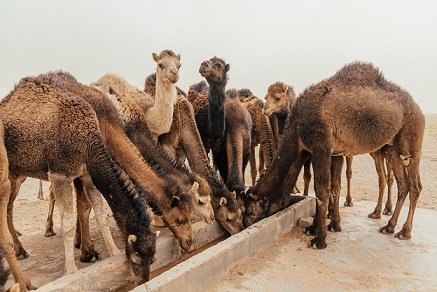The world is full of fascinating creatures; among them, the Dulla camel stands out as a remarkable and distinct member of the camel family. Originating from the arid landscapes of the Middle East, Dulla camels have a unique history, physical characteristics, and cultural significance that make them a subject of great interest. In this article, we will take a journey to explore the Dulla camel’s world, from its roots to its prospects.
Table of Contents
ToggleOrigin and History
Dulla camels have a long and storied history dating back centuries. These magnificent creatures are native to the Arabian Peninsula and have played a significant role in the region’s culture and trade. Historically, nomadic desert dwellers used them as essential companions, as they were well adapted to the harsh desert environment.
Physical Characteristics
Dulla camels are easily recognizable due to their distinctive features. Their most striking attribute is their long, curved neck, which enables them to graze on hard-to-reach desert vegetation. Their humps are large and prominent, storing fat reserves that help them survive in the arid desert for extended periods. Their coat color varies from a light sandy hue to a deeper brown, camouflaging them well in the desert landscape.
Habitat and Distribution
These camels are primarily found in the deserts of the Middle East, with a substantial population residing in Saudi Arabia, the United Arab Emirates, and other Gulf countries. They have also been introduced to other parts of the world with arid environments.
Cultural Significance
Dulla camels are highly regarded in Middle Eastern cultures and have vital cultural significance. They symbolize endurance and resilience, often celebrated in local folklore, songs, and poetry. These camels have also been part of various traditional ceremonies and events.
Economic Importance
Dulla camels are more than just cultural icons; they also play a crucial role in the economy of the Middle East. Their meat, milk, and hides are valuable commodities, contributing significantly to the livelihood of many people in the region.
Dulla Camel in Agriculture
One of the primary roles of Dulla camels in the region is their contribution to agriculture. They are used in plowing fields and transporting goods, making them indispensable for many farming communities in arid areas.
Health Benefits
Dulla camel products, such as camel milk, are known for their health benefits. Camel milk is a rich source of nutrients and is believed to have medicinal properties. It has gained popularity as a superfood in recent years.
Conservation Efforts
Due to various factors, including habitat loss and overhunting, Dulla camels have faced a decline in numbers. Conservation efforts are underway to protect and preserve these unique camels, ensuring their survival for future generations.
Challenges Faced
Despite their significance, Dulla camels face several challenges, including habitat destruction, climate change, and competition with modern transportation. These challenges pose a threat to their existence.
Future Prospects
The future of Dulla camels remains to be determined. Their significance in Middle Eastern culture and economy is undeniable, but efforts must be made to ensure their conservation and sustainable use. The global community plays a crucial role in shaping the future of these remarkable creatures.
Breeding and Genetics
Dulla camels have distinct genetics adapted to their desert environment. Breeding programs are being developed to maintain and improve these unique genetic traits.
Dulla Camels vs. Other Camel Species
While Dulla camels are closely related to other camel species, such as the Bactrian camel, they have unique characteristics that set them apart. Their adaptability to desert environments makes them a standout.
Interesting Facts
- Dulla camels can drink much water at once, rehydrating themselves for the arid desert.
- Their milk has a unique flavor and is lower in fat than cow’s milk.
- Dulla camels are known for their exceptional sense of direction and are often used as guides by desert travelers.
Conclusion
The Dulla camel, with its rich history, cultural significance, and economic importance, is a true treasure of the desert. While facing challenges, their unique genetics and adaptability make them a symbol of resilience. As we look to the future, ensuring their survival and continued contribution to the world is imperative.
FAQs about Dulla Camels
- Are Dulla camels a separate species of camel?
- No, Dulla camels are a subspecies of the Arabian camel, known for their unique adaptations.
- What are the primary products derived from Dulla camels?
- Dulla camels provide meat, milk, and hides, with camel milk gaining popularity for its health benefits.
- How do Dulla camels survive in the desert’s harsh conditions?
- Their ability to store water and fat in their humps and their efficient use of water allows them to thrive in arid environments.
- Are there any specific conservation efforts in place to protect Dulla camels?
- Various organizations and governments are actively working to conserve and protect the Dulla camel population.
- Can Dulla camels be found outside of the Middle East?
- Dulla camels have been introduced to other arid regions worldwide, but their primary habitat remains the Middle East.





